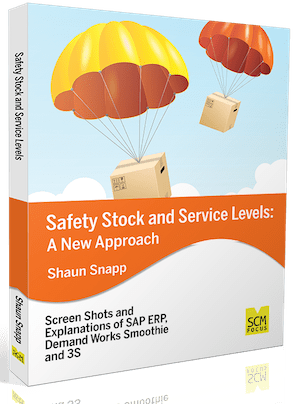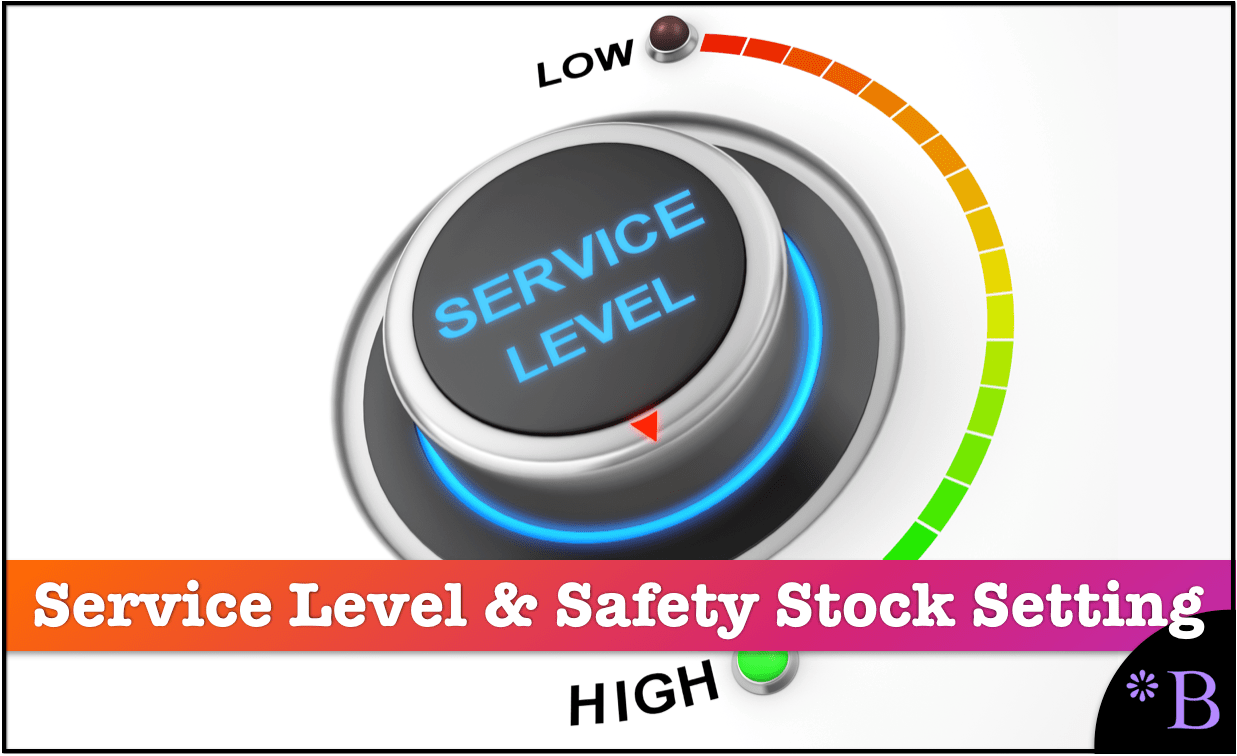Safety Stock and Service Levels: A New Approach
Screenshots and examples from SAP APO, Demand Works Smoothie, 3S.
What the Book is About
A thoroughly researched explanation of how to leverage safety stock in systems for supply planning. This book explains many of the great misunderstandings that surround safety stock, including the aspect of safety stock that is missed on many practitioners. Safety stock is one of the most discussed inventory management parameters in supply chain management. However, safety stock is set very inefficiently at most companies. This observation comes from reviewing the safety stock settings at many companies on the part of the author. What is little known or at least little discussed is that the methods of setting safety stock within the vast majority of supply planning systems — even supposedly advanced methods such as dynamic safety stock, miss out on many of the important attributes of safety stock setting. This book provides a full explanation of why, and then what to do about it. Safety stock is inherently linked to service levels. However, while many companies make bold proclamations surrounding service level attainment, they generally do not have good ways of quantitatively determining service levels.
Safety stock is one of the most commonly discussed topics in supply chain management. Every MRP application and every advanced planning application on the market have either a field for safety stock or can calculate safety stock. However, companies continue to struggle with the right level to set it. Service levels are strongly related to safety stock, yet companies also struggle with how to set service levels.
The vast majority of systems allow the setting of safety stock by multiple means (static, dynamic, adjustable with the forecast in days’ supply, etc..), however, most systems do not allow the safety stock to be set in a way that is considerate of the inventory that is available to be applied.
Buy Now
By reading this book you will:
- Review the standard approaches of setting safety stock and service levels.
- Learn surprising features within supply chain planning and ERP applications that hold companies back from effectively management safety stock.
- Learn how to improve safety stock and service level management.
- Learn how to incorporate these improved values into the system.
A Book Based in Reality
The book provides many examples from real life project experiences, the emphasis being on the reality of supply planning projects.
Interconnected to Web Information
In order the keep the book at a manageable and easily readable length, the book also provides numerous links out to the Brightwork Research & Analysis site, where supporting articles allow readers to get into more detail on topics that interest them.
Buy Now
Chapters
- Chapter 1: Introduction
- Chapter 2: Safety Stock and Service Levels from a Conceptual Perspective
- Chapter 3: The Common Ways of Setting Safety Stock
- Chapter 4: The Common Issues with Safety Stock
- Chapter 5: Common Issues with Service Level Setting
- Chapter 6: Service Level Agreement
- Chapter 7: Safety Stock and Service Levels in Inventory Optimization and Multi Echelon Software
- Chapter 8: A Simpler Approach to Comprehensively Setting Safety Stock and Service Levels
Table of Contents
Chapter 1: Introduction
- Books and Other Publications on Safety Stock and Service Level
- The Use of Screen Shots in the Book
- Timing Field Definitions Identification
- How Writing Bias is Controlled at Brightwork Research & Analysis and Brightwork Research & Analysis Press
- The Approach to the Book
- Important Terminology
- The Brightwork Research & Analysis Site
- Intended Audience
- Abbreviations
Chapter 2: Safety Stock and Service Levels from a Conceptual Perspective
- The State of Safety Stock
- Service Level From the Conceptual Perspective
- The Surprising Conclusion Regarding How Service Levels are Set
- Why Things Don’t Change With Respect to Service Level Setting
- Schizophrenic Service Level Setting
- Should Service Levels be Lowered?
- Service Level Attainability
- Conclusion
Chapter 3: Common Ways of Setting Safety Stock
- Manual Approximation
- How Manual Approximation Works in Practice
- Day’s Supply Combined With a Fixed Value
- How Day’s Supply With Fixed Value Works in Practice
- The Dynamic Safety Stock
- How Dynamic Safety Stock Works in Practice
- Conclusion
Chapter 4: Common Issues with Safety Stock Setting
- Conclusion
Chapter 5: Common Issues with Service Level Setting
- Issue 1: Setting the Service Levels Close to Uniform for Each Product Location
- Issue 2: Service Level Attainment Fudging
- Issue 3: A Lack of Ability to Calculate Service Levels Based Upon Input Factors
- Issue 4: A Misimpression of the Customer Service Level Requirement
- Issue 5: No Ability to See the Inventory Costs of Various Service Levels
- Issue 6: The Setting of Service Levels Without an Attempt to Manage the Service Level
- The Root Cause of These Issues
- Conclusion
Chapter 6: Service Level Agreements
- The History of SLAs
- Standard Limitations in Supply Network Control
- Reducing Friction between the Sales Organization and Supply Chain
- Providing a Menu of Options to Customers
- Conclusion
Chapter 7: Safety Stock and Service Levels in Inventory Optimization and Multi Echelon Software
- The Definition of Inventory Optimization
- How Inventory Optimization Works
- Dynamic Safety Stock
- Conclusion
Chapter 8: A Simpler Approach to Comprehensively Setting Safety Stock and Service Levels
- Important Requirements for Both Service Level and Safety Stock Setting
- Safety Stock Calculation Requirements
- Service Level Calculation Requirements
- Requirements That Apply to Both Service Level and Safety Stock
- Other Inventory Parameters
- The Reality of Supply Planning Parameters
- Giving the Business the Parameter Support it Needs
- Calculating the Values
- An Inventory Parameter Calculation Project
- The 3S Calculator
- Simplified Constraints in 3S
- S&OP in 3S
- Conclusion
Chapter 9: Conclusion

Buy Now
Questions about the Book?
Do you have any questions about the book? If so please leave us a comment in the message box to the right, and we will address them.
